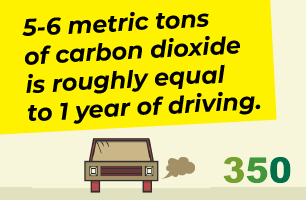 What is building electrification and how does it fit in with a plan to reduce greenhouse gases?
What is building electrification and how does it fit in with a plan to reduce greenhouse gases?
Buildings in California represent 20-25% of the state’s total greenhouse gas (GHG) emissions.
Building electrification is the replacement of gas appliances (furnaces, water heaters, dryers, stoves) with all-electric heat pump and induction technology, and the addition of electric vehicle (EV) chargers.
 Then, as SMUD moves towards 100% renewables, the carbon footprint of the building shrinks. Every 5 to 6 metric tons of carbon dioxide (CO2) saved is like taking a car off the road for a year. In a residential setting, setting up one house with a heat pump water heater and HVAC can save an estimated 34 tons of CO2 over the appliances’ lifetime. 1000 single family residential buildings constructed all-electric could save 5000 to 6000 vehicle years of CO2, just with the HVAC and water heating systems.
Then, as SMUD moves towards 100% renewables, the carbon footprint of the building shrinks. Every 5 to 6 metric tons of carbon dioxide (CO2) saved is like taking a car off the road for a year. In a residential setting, setting up one house with a heat pump water heater and HVAC can save an estimated 34 tons of CO2 over the appliances’ lifetime. 1000 single family residential buildings constructed all-electric could save 5000 to 6000 vehicle years of CO2, just with the HVAC and water heating systems.
In the Sacramento Region, concern over climate change has resulted in multiple agencies declaring Climate Emergencies, setting earlier goals for GHG reductions, including the City of Sacramento. But arguably the strongest statement taken here has been by SMUD, which has pledged to make their electricity production carbon neutral by 2030. What this means is that most electric appliances installed today will be carbon neutral before they are replaced; and will be on their way to carbon neutral from now until then. This will only make the GHG savings from all-electric buildings larger.
What are the issues with using gas in homes beyond GHG?
 Beyond GHGs, there are health risks associated with burning natural gas indoors, including increased exposure to NOx and formaldehyde. Studies have found that the indoor air in homes burning natural gas have illegal levels of these pollutants. [1] Children living in a home with a gas stove are 42% more likely to have current asthma. [2] These impacts are heightened in smaller homes with unventilated or improperly vented gas stoves.
Beyond GHGs, there are health risks associated with burning natural gas indoors, including increased exposure to NOx and formaldehyde. Studies have found that the indoor air in homes burning natural gas have illegal levels of these pollutants. [1] Children living in a home with a gas stove are 42% more likely to have current asthma. [2] These impacts are heightened in smaller homes with unventilated or improperly vented gas stoves.
Gas connections to homes are also a risk when disasters like earthquakes or wildfires occur, because they can cause explosions, and continue burning. A pipeline catches fire every four days in the United States and results in an explosion every eleven days, an injury every five days, and a fatality every twenty-six days. [3] Beyond that, there is the risk of leaks, or ignition failure, which is why carbon monoxide detectors are required in homes with gas heaters. Some proponents of natural gas have argued that in order to be able to have continuity of heating or cooking during power outages, like those being done to reduce risk of wildfires on windy days, gas can be relied on; but in reality, many gas appliances currently in use rely on electric ignition and won’t work when the power is off.
What is the City of Sacramento proposing to do?
The City of Sacramento is currently proposing an ordinance that would require new low-rise construction to be all-electric starting with permits issued in 2023, and expanding to include mid and high-rise construction in 2026.
They are also looking to have other measures that address existing buildings, and some of that can be seen in the Climate Action Plan proposal. The City’s website for the electrification ordinance is a great resource for learning about the background of the ordinance, reading the ordinance and comments made by stakeholders (including 350 Sacramento!), and watching webinars where leaders in the building, kitchen, and industrial applications of all-electric technology show the feasibility of building decarbonization today, and discuss questions from members of the community. This ordinance will be heard on March 2 at the Law and Legislation meeting and then go before City Council.
What is 350 Sacramento doing?
We support this ordinance being passed, though we want a very limited exception process and would also like to see the City of Sacramento go further by including providing educational information during the permitting process for remodels and appliance replacement and by pro-actively supporting the electrification of low-income homes.
We need to make 2030 a big year.
We know climate change is an existential threat. We need to acknowledge that to address that threat we need to change. Building electrification is an important part of this change, and one that we can address at the local level. We need to start that change now. Contact Rosie for more info.

Written by Rosie Y.
[1] Logue JM, Klepeis NE, Lobscheid AB, Singer BC. 2014. Pollutant exposures from natural gas cooking burners: a simulation-based assessment for Southern California.
[2] Weiwei Lin, Bert Brunekreef, Ulrike Gehring, Meta-analysis of the effects of indoor nitrogen dioxide and gas cooking on asthma and wheeze in children.
[3] Mall, A. Pipeline Incident Statistics Reveal Significant Dangers. 2 Jan 2019. Natural Resources Defense Council Expert Blog.




Comment(1)
Glayol Sahba says:
February 28, 2021 at 6:36 pmGreat article , Rosie! It is concise and understandable and nicely supported!
Thanks so much!!!